Vintage: new is not always better!
Sewing has been part of my life since I was very small (that is me on the left playing with my grandmother’s sewing machine (1969). The important ladies in my life knew how to stitch and passed their love of stitching and knowledge onto me. My Mother knew how to fashion home decor items and clothing for kids and adults. My Grandmother spent many years working in Silk-o-Lina, a ladies wear, sewing goods and alterations store. She was well trained and practised with a sewing machine and thread. My favourite aunt knew how to turn fabric into dolls and toys that I still cherish today. I am indebted to these talented ladies for sharing their knowledge and their patience as I learned the skills of the trade. These skills have served me well for over 40 years (and counting) and I am still learning new and exciting techniques.
Stitching helps…
- me make my home comfortable
- helps me keep my children warm and clothed
- me capture and make memories
- helps me generate income
- me be patient and encourages dedication
- me to pay close attention to detail
- me see that rules provide structure, but must be broken often
- me maintain personal peace and balance
When things get crazy and the chaos of life creeps in, I pull out yarn and needles or dig into my fabric stash for something that inspires me to stitch up a skirt, a pillow, or a nifty new bag.
Stitching helps me navigate life.
New is not always better!
Only once in my stitching career have I owned a brand new machine. It was an entry level Pfaff that served me well for ten years. Sadly, the transmission blew and it was quickly shipped off to the sewing machine graveyard. My Mom, an expert bargain hunter, found an old Baycrest branded Riccar (circa early 1960s) sewing machine to replace the Pfaff. Little did I know that this solution would lead to a lifelong love of vintage sewing machines.
Today, I’d be hard pressed to spend thousands dollars on a modern machine with all sorts of bells and whistles. The offerings are shiny and new, but complicated and difficult to work with. They are built with plastic and thin metal-like substances. They are frustrating to troubleshoot when things go wrong. They are light and prone to jumping when stitching at high speeds. They do not like bulky layers and complain by skipping stitches and breaking needles.
Modern machines, in my humble opinion, are soulless tools that lack character and soul.
Modern machines are not of the same quality as the machines created in the early 1900s through to the 1970s or so. They might have loads of features and options that allow the stitcher to add beauty and interest to their work, but we don’t really need all those complicated computerised features. All we really need to create quality items is a machine that stitches straight and true.
Enter vintage!
Vintage machines have everything we need. Their stitching remains straight and true and has withstood the test of time. Manufacturer’s concentrated on creating quality tools that brought both function and beauty to many homes throughout the world. Many of them have outlasted generations of stitchers and continue to help us create beautiful items that help us add beauty to our homes, keep our families warm and comforted, and enable us to produce income.
Vintage sewing machines are like time portals to our past. They help us connect to previous generations of stitchers. They keep us grounded to our stitching roots.
Vintage sewing machines have the ability to transport us into the hearts and minds of the stitchers of yesterday. Each one has a story to tell.
This is why I love vintage machines.
Meet my sewing family…
I now own eight vintage machines. Each one is unique and has its own story to tell. Let me introduce you to my stitcherly family (the strikethrough description indicates that I no longer have the machine):

Betsy, the Baycrest (Riccar, circa early 1960s): Betsy was gifted to me by my Mom. I had blown the transmission in my entry level Pfaff sewing machine and needed a replacement ASAP. She was rescued from a local garage sale and quickly became my go-to machine. Betsy features a reliable zigzag stitch, has a built-in buttonhole function, and offers a few decorative and functional stitches. She is a sturdy stitcher and can handle anything from delicate lingerie fabrics to sturdy denim. She does okay with bulky layers, but would prefer to stitch more reasonable thicknesses. She lives in a wood-like cabinet that offers loads of storage and creates a stable base for her. Betsy is operated by a knee drive.
Sadly, I am running out of room and looking for a new home for Betsy. She was last serviced in March 2015 and ready to meet her new sewist. She will accomplish everything a home sewist needs. She has a great straight stitch, a few embroidery stitches, built in buttonhole, and zigs and zags like a pro.- In August 2015, Betsy went home with her new sewist. She is still stitching and loves her new home.
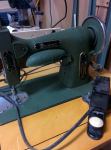
Basil, the White 77 (rotary): Basil was another garage sale find. He is strong and doesn’t shy away from projects that have thick layers of fabric. He was branded by the Eaton’s department store with the Viking name. He has a complete compliment of rotary style attachments – from blind hemmers to binders to ruffle and shearing attachments. Basil’s exact year of creation is still a mystery. He is currently experiencing a few tension issues, but I’m learning how to help him become a functional and productive member of my sewing family. His electrics and hardware are in great condition.
- April 2017: This machine was donated to our local thrift store.
 Rosemary, the 1948 Singer 15-89 treadle: Rosemary is in perfect condition. She features a beautiful and consistent stitch and is euipped with reverse for back tacking. She has a complete compliment of attachments, including Singer’s buttonhole attachment. Singer’s button holer creates the perfect key-hole style buttonholes each and every time. Rosemary belonged to my husband’s grandmother and helped his mother learn to stitch. She lives in a beautiful five drawer solid wood cabinet.
Rosemary, the 1948 Singer 15-89 treadle: Rosemary is in perfect condition. She features a beautiful and consistent stitch and is euipped with reverse for back tacking. She has a complete compliment of attachments, including Singer’s buttonhole attachment. Singer’s button holer creates the perfect key-hole style buttonholes each and every time. Rosemary belonged to my husband’s grandmother and helped his mother learn to stitch. She lives in a beautiful five drawer solid wood cabinet.
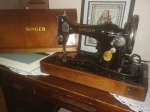 Thyme, the 1936 Singer 128: Most of my machines are stationary. When I discovered the need to be more mobile, I began a search for a vintage travel machine. My search began with Thyme (and still going!). She is operated by a knee drive and housed in a lovely, nearly perfect, bent wood case. Her value is beyond measure. Even though she lacks reverse, she is quiet and powerful. Thyme uses a vibrating shuttle bobbin mechanism that, in my opinion, provides a better tension than other types of bobbin mechanisms.
Thyme, the 1936 Singer 128: Most of my machines are stationary. When I discovered the need to be more mobile, I began a search for a vintage travel machine. My search began with Thyme (and still going!). She is operated by a knee drive and housed in a lovely, nearly perfect, bent wood case. Her value is beyond measure. Even though she lacks reverse, she is quiet and powerful. Thyme uses a vibrating shuttle bobbin mechanism that, in my opinion, provides a better tension than other types of bobbin mechanisms.
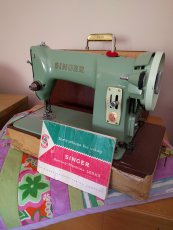
Sage, the Singer 185K-3 (1960): Sage was known as Singer’s little green machine. These machines were produced between 1958 and 1964. Don’t let her size and cuteness fool you, though. She is very powerful and stitches through almost anything a stitcher can throw at her. She features reverse and a horizontal oscillating hook drop-in style bobbin. The 185K was Singer’s answer to updating the popular 99K. She is heavy but a very fast stitcher. My daughter loves this machine and has claimed ownership of her. (The K notes that the machine was manufactured in the United Kingdom plant.)
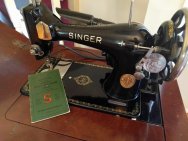 Liz Tailor, the Singer 128-13: Liz is the most glamourous member of my sewing family. She has been well maintained over the years and simply sparkles. This electric sewing machine, manufactured in St. John’s, Quebec, between 1945 and 1948, features the vibrating shuttle bobbin mechanism. Liz’s cabinet shines as brightly as her metallic black finish. It has inlaid parquet work that makes her even more of a star on any stage.
Liz Tailor, the Singer 128-13: Liz is the most glamourous member of my sewing family. She has been well maintained over the years and simply sparkles. This electric sewing machine, manufactured in St. John’s, Quebec, between 1945 and 1948, features the vibrating shuttle bobbin mechanism. Liz’s cabinet shines as brightly as her metallic black finish. It has inlaid parquet work that makes her even more of a star on any stage.
 Ginger, the Singer 191B: Ginger is a lovely light beige (with a pink undertone) machine that I rescued from a local thrift store. She is in a beautiful solid wood cabinet that has a bench with a removable seat lid that allows for storage. She came with a full compliment of attachments and features both reverse and and the ability to drop her feed dogs by turning a dial. Ginger has the perfect straight stitch, is easy to use, and compliments any decor.
Ginger, the Singer 191B: Ginger is a lovely light beige (with a pink undertone) machine that I rescued from a local thrift store. She is in a beautiful solid wood cabinet that has a bench with a removable seat lid that allows for storage. She came with a full compliment of attachments and features both reverse and and the ability to drop her feed dogs by turning a dial. Ginger has the perfect straight stitch, is easy to use, and compliments any decor.

Agave, the Singer 328 Stylemate (1968): Agave is a beautiful machine that allows for a bit more creativity. His stitches are straight and even, but it is the fashion discs that appeal to me. Nine discs allow Agave to perform a range of stitches from zigzags and satin stitches to more decorative accent stitches. He is a decorative demon that adds beauty and fun to most projects. Agave needs a new cabinet, but otherwise works to perfection.
- As of July 2015, Agave lives with a good friend. Since Cinnamon, 1958 Singer 401a, came to live with me, he is no longer needed. Rest assured that his seamstress will love and care for him as I have. I will pop in on him now and again to make sure he is oiled and running well.
- Agave’s baby brother came to live with us during September 2015. His motor is strong and healthy, but he is missing a few parts. My husband and I plan to bring him to life again.
Agave, the Singer 328 Stylemate (1968): Agave is a beautiful machine that allows for a bit more creativity. His stitches are straight and even, but it is the fashion discs that appeal to me. Nine discs allow Agave to perform a range of stitches from zigzags and satin stitches to more decorative accent stitches. He is a decorative demon that adds beauty and fun to most projects. Agave needs a new cabinet, but otherwise works to perfection.
 Cinnamon, the 1958 Singer 401a: She is a strong stitcher with the ability to get a little fancy. She uses top hat cams to accomplish some of stitches (I hope to collect all available cams for her), but most of the fancy stitches, zig zags, and scallops are accomplished by adjusting the two stitch dials on the front. She does a great satin stitch that allows me to experiment with a bit of machine embroidery and custom embellishments, like monogramming. Cinnamon is a slant machine, which means that there is more of the needle exposed.
Cinnamon, the 1958 Singer 401a: She is a strong stitcher with the ability to get a little fancy. She uses top hat cams to accomplish some of stitches (I hope to collect all available cams for her), but most of the fancy stitches, zig zags, and scallops are accomplished by adjusting the two stitch dials on the front. She does a great satin stitch that allows me to experiment with a bit of machine embroidery and custom embellishments, like monogramming. Cinnamon is a slant machine, which means that there is more of the needle exposed.
My husband and I rescued this 1922 Singer 127 treadle from my his aunt, who was going to abandon her at the dump. Yes, there are people in this world that abandon these beauties to the elements. They are unloved. They are many. Hibiscus now lives in my dining room and is the first machine that greets visitors as they enter my home. She is embellished with nearly perfect Sphinx decals that shine in the morning sun. She has a bit of “pin rash” around her neck where former seamstresses would attach a piece of cloth to hold pins. I am in the process of cleaning her up, but she works well. She has a vibrating shuttle bobbin mechanism and doesn’t skip a stitch.
rescued this 1922 Singer 127 treadle from my his aunt, who was going to abandon her at the dump. Yes, there are people in this world that abandon these beauties to the elements. They are unloved. They are many. Hibiscus now lives in my dining room and is the first machine that greets visitors as they enter my home. She is embellished with nearly perfect Sphinx decals that shine in the morning sun. She has a bit of “pin rash” around her neck where former seamstresses would attach a piece of cloth to hold pins. I am in the process of cleaning her up, but she works well. She has a vibrating shuttle bobbin mechanism and doesn’t skip a stitch.
 My husband gifted me this 1948 Singer 201K-3, Lavender, in December 2015. It is becoming more and more difficult for me to sew on a treadle machine or use a foot pedal due to the lack of feeling in my feet (or too much feeling that is very painful). I suffer from Osteoarthritis and Diabetes 2, which makes things a bit difficult for me. I began searching high and low for machines that were in cabinets operated by the knee instead of the more common foot pedal on the floor. Lavender has given me my stitching life back. As long as I remember to move regularly, I can sit and stitch once again. Lavender also has a full compliment of accessories, including:
My husband gifted me this 1948 Singer 201K-3, Lavender, in December 2015. It is becoming more and more difficult for me to sew on a treadle machine or use a foot pedal due to the lack of feeling in my feet (or too much feeling that is very painful). I suffer from Osteoarthritis and Diabetes 2, which makes things a bit difficult for me. I began searching high and low for machines that were in cabinets operated by the knee instead of the more common foot pedal on the floor. Lavender has given me my stitching life back. As long as I remember to move regularly, I can sit and stitch once again. Lavender also has a full compliment of accessories, including:
- Button hole attachment
- ZigZag attachment
- Ruffler
- Foot and Adjustable Hemmers
- Binder
- Tucker
Lavender is now my main machine. From denim to cotton to chiffon, Lavender delivers the perfect stitch each and every time. The feature I’m most looking forward to trying out is her feed dog drop. I’m working on a lap quilt that was pieced on and will be quilted on Lavender.
 My husband is no longer immune to the vintage sewing machine (VSM) lifestyle. He found Rose in January 2016. She is a centennial edition Singer 15-90 in a bent wood case. Rose has seen a lot of stitching throughout her lifetime and needed a lot of tender loving care. My husband was able to remove most of the dings from her base and is currently working on the dome. She will need a new electric cord, as hers is cracked and taped and dry.
My husband is no longer immune to the vintage sewing machine (VSM) lifestyle. He found Rose in January 2016. She is a centennial edition Singer 15-90 in a bent wood case. Rose has seen a lot of stitching throughout her lifetime and needed a lot of tender loving care. My husband was able to remove most of the dings from her base and is currently working on the dome. She will need a new electric cord, as hers is cracked and taped and dry.
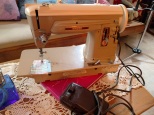
Meet Cinnamon’s (the Singer 401a above) brother, Dandy (short for Dandelion). He is a Singer 404, the base model of Singer’s slant machine series. Dandy is an extra durable, sturdy, powerful machine with a drop in bobbin. He makes a most perfect straight stitch and will take on any of Singer’s slant attachments. He works well on his own or in a cabinet. He is not as portable as the 301 or a Featherweight, but he will work steady and true (he is very very heavy).
- Dandy is moving in with my sister. I gifted her this machine to my sister for her birthday in 2016. It is her first slant machine.
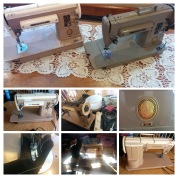 The Twins are a pair of Singer 301s from the mid 1950s. They are lightweight (very portable), quiet, and fast. They are a bit more sturdy than the Singer Featherweights, but stitch just as well. These are slant machines and will handle the attachments for Singer’s slant series. I’m not sure you actually get a better view of the needle or your work, but they are beautiful machines to use.
The Twins are a pair of Singer 301s from the mid 1950s. They are lightweight (very portable), quiet, and fast. They are a bit more sturdy than the Singer Featherweights, but stitch just as well. These are slant machines and will handle the attachments for Singer’s slant series. I’m not sure you actually get a better view of the needle or your work, but they are beautiful machines to use.
Some consider the 301 the big brother to the the Featherweight, but this is a myth. The 301 and the Featherweights share the same bobbin case and both are cast from aluminum, which makes them light and portable. But that is where the similarities end. The 301
Many people call the 301 the big sister to the featherweight but that is incorrect.
They share the same bobbin case and both are cast from aluminum. Other than that they are different class machines. The 301 will produce 1,500 spm. It works as a table top machine or is easily mounted in your favourite cabinet. So, rather than the big sister, I think the 301 is more of a favourite cousin to the Featherweight.
 Every so often the stars align and the fates smile upon us mere mortals. Today (June 16, 2016) is one of those days! The sewing goddess directed me to this beautiful 1955 Singer Featherweight 221K. Her name is Daisy.
Every so often the stars align and the fates smile upon us mere mortals. Today (June 16, 2016) is one of those days! The sewing goddess directed me to this beautiful 1955 Singer Featherweight 221K. Her name is Daisy.
I’ve been waiting a very long time for a Featherweight to find me. They are light, quiet, and sew a good quality stitch. She came with a complete set of attachments and a button hole attachment . (As an added bonus, I found a set of white cams in the case that will work with my Singer Automatic ZigZagger!) Daisy’s case is a little beat up here and there, but it adds character to her.
Daisy’s previous owner bought her brand new 55 years (just before she married and started a family in Weyburn, Saskatchewan). She found that sewing was not her thing. She was more of a knitter/crocheter and decided it was time to part ways with Daisy. Daisy was fully serviced in 2009 and hasn’t been used since.
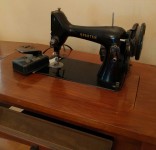
The Singer Spartan 192 was Singer’s economy sewing machine. It is a bare bones straight stitch machine with reverse. Spartans were born of a need for Singer to compete with cheaper, less expensive imports. The Spartan is really a stripped down 99. There is no light (and nowhere to mount a light on this one), and no decals. It is a 3/4 sized machine. This machine has been well loved over its life time. It needs a deep cleaning, new electrical cord, a bit of repair to the bobbin cover, and the cabinet needs refinishing.
This is the before picture. I hope to begin the restoration process
soon. I found this little cutie in July 2016.- April 2017: This machine was donated to our local thrift store.
 I’ve wanted to include a Singer 500a (name is forthcoming) in my collection since I fist set eyes on them. I was lucky enough to find one at good price in August 2016. The 500a, in my opinion, really lives up to Singer’s pledge that “What’s new for tomorrow is at Singer today!” The 500a is an updated version of Singer’s 401a. Singer made a few cosmetic changes, enclosed the thread spool pins inside the lid, and moved the bobbin winder. Otherwise, the machines are the same. The 500a is known as the Rocketeer due to its futuristic styling. It reminds me of something that Mrs. Jetson would use!
I’ve wanted to include a Singer 500a (name is forthcoming) in my collection since I fist set eyes on them. I was lucky enough to find one at good price in August 2016. The 500a, in my opinion, really lives up to Singer’s pledge that “What’s new for tomorrow is at Singer today!” The 500a is an updated version of Singer’s 401a. Singer made a few cosmetic changes, enclosed the thread spool pins inside the lid, and moved the bobbin winder. Otherwise, the machines are the same. The 500a is known as the Rocketeer due to its futuristic styling. It reminds me of something that Mrs. Jetson would use!
 This Singer 774 (came along with the 500a above – August 2016). It sews well and is the most modern of my machines. It is simple enough to handle any beginner sewer’s learning curve and has enough features to serve the most advanced sewer’s needs. For the most part, I leave my Singer monogrammer connected to this machine. On the rare occasion that I need to use a free arm, this is the machine that accomodates need. All of her accessories and the original manual are with this machine.
This Singer 774 (came along with the 500a above – August 2016). It sews well and is the most modern of my machines. It is simple enough to handle any beginner sewer’s learning curve and has enough features to serve the most advanced sewer’s needs. For the most part, I leave my Singer monogrammer connected to this machine. On the rare occasion that I need to use a free arm, this is the machine that accomodates need. All of her accessories and the original manual are with this machine.
Singer produced these machines in the 1970s. It has plastic gears, drop-in bobbin, adjustable stitch lenght and width, and an adjustable needle position. It accomodates twin needle stitching. It has a suite of basic specialty stitches and will stitch a decent button hole. This machine will stitch through delicate fabric and accomodate some heavier weight fabrics.
 This Singer Style-o-Matic, model 328 (became part of my sewing family in March of 2017), was born in 1961. It came complete with all its attachments and fashion discs, which produce a variety of decorative stitch patterns. It has a complete set of attachments common to Singer machines at the time. It also has its original manual. The machine can be used on a table top and has a protective case that covers the machine. It also fits into a blonde desk.
This Singer Style-o-Matic, model 328 (became part of my sewing family in March of 2017), was born in 1961. It came complete with all its attachments and fashion discs, which produce a variety of decorative stitch patterns. It has a complete set of attachments common to Singer machines at the time. It also has its original manual. The machine can be used on a table top and has a protective case that covers the machine. It also fits into a blonde desk.
One of my best friends saw this machine with a “free to a good home” sign on it across the street from him. He quickly stowed the machine away in his garage where it awaited pick up. It needs a little love and a good cleaning, but will be stitching along soon.
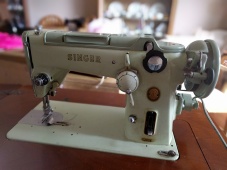 This Singer 319 was born in 1957 and became part of my sewing family in April 2017. I do not know a whole lot about this vintage beauty, but will update this page as I learn more. It came along with all its attachements and a full set of stich discs. It was well maintained by its previous owner, but will need a good cleaning along with a bit of grease.
This Singer 319 was born in 1957 and became part of my sewing family in April 2017. I do not know a whole lot about this vintage beauty, but will update this page as I learn more. It came along with all its attachements and a full set of stich discs. It was well maintained by its previous owner, but will need a good cleaning along with a bit of grease.
I’ve had the 319 on my wish list because of its unique styling and ability to stitch a variety of stitches. Its “piano key” type stitch control, combined with the stitch discs, are capable of producing hundreds of decorative and functional stitches. This machine uses a 20U bobbin and a Type 206 x 13 needles, which has a shorter point than the classic 15 x 21 needle. Using the wrong needle type could spell disaster for the bobbin case. This machine came with two needle cases and, I hope, is capable of using both needle types. A little experimentation is warranted.












Thank you for sharing your story and lovely pictures with us, Bonnie. I enjoyed hearing about the background of all you’re sewing machines. They are all lovely!
Thanks, Suzanne! I am so glad you enjoyed our story. I am always looking to expand my family. I love vintage machines.
This is a great post. I loved meeting your machines.
Thanks, Sally! I must add my new babies to this post. I must add Cinnamon, my 1956 Singer 401a, and Hibiscus, my 1922 Singer 127 treadle. Hibiscus has the most beautiful Sphinx decals. She needs a lot of love and cleaning, but I’ll have her stitching a Bionic Gear Bag in no time.
Hi there!
I’m on a search for a mid -late 60s Pfaff that had a dual side clasp carrying case in green…
Simple, heavy, 2 stitches, no front side plastic knobs.
By chance was this the machine you had?
I’m on a desperate search to find the machine my mom used and passed on to me that we both later traded in for an upgrade.
Totally naive to the world of vintage machines… especially non Singers.
Anything helps!
And yes, you have a lovely collection… if only I had the space and cash to begin collecting!
Wow what an amazing collection of machines. I have major machine envy of Hibiscus.
Hibiscus is one of my favourite machines. She sees like a dream.
Wow! That is an incredible collection and great stories.
I have an old Elna Supermatic (that needs servicing) that my mom got me for Christmas 16 years ago. I love my knee switch baby.
Knee drives are the very best. Thyme and Lavender both are knee operated. I don’t always have feeling in my feet any more and that makes foot pedals difficult. Knee drives keep me stitching.
Thank you for sharing the stories behind all your lovely machines! You have an enviable collection, that’s for sure!
Thank you so very much! I’ve always belled that each machine has a story to tell. It is up to us to listen.
Bonnie, I loved reading about your machines! It’s been said that every picture tells a story, but you tell a story for every picture. Bravo! And well done.
Thanks, Mary. I love my machines. They do have stories to tell. Each story us unique.
I learned to sew on a Singer 774 in high school. My parents bought me an identical machine. I wish I still had it!!
The vintage machines are amazing, Tammy.
https://polldaddy.com/js/rating/rating.jshttps://polldaddy.com/js/rating/rating.jsThanks for all the lovely pics, I love seeing people’s machines. I was wondering if I might ask you a question: do you need stabilizer to zig zig on your 401a? I’m having a hard time getting the fabric not to bunch even on the lowest tension setting, and someone suggested I use it. It didn’t seem quite right to have to use it on machine that should just normally zig zag, but I thought I’d ask. Thanks!
Thanks for stopping by. No, I don’t use a stabilizer to zig zag on any machine. Have you tried adjusting the foot pressure? Maybe loosening it a bit will help with the bunching. If you are sewing with a knit,very stretching it slightly as you sew. 🐱
Hi! I was wondering if you could help me in my search for the manual to a Baycrest Model 3700?
I am so sorry, Beth, but I am of no help. I didn’t have one for mine, but didn’t really need it. The machine was simple enough.
Unfortunately, I don’t know this machine or have access to the manual. Good luck!